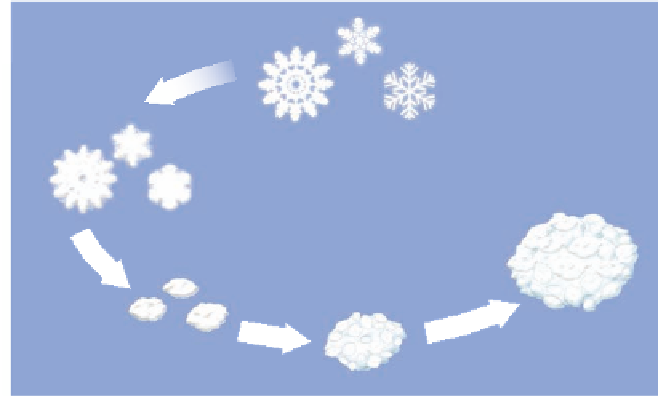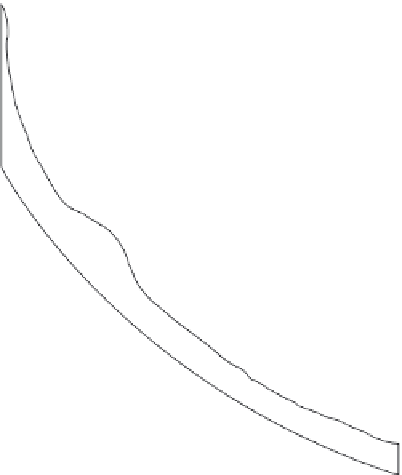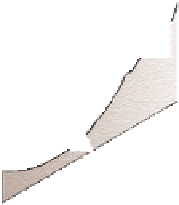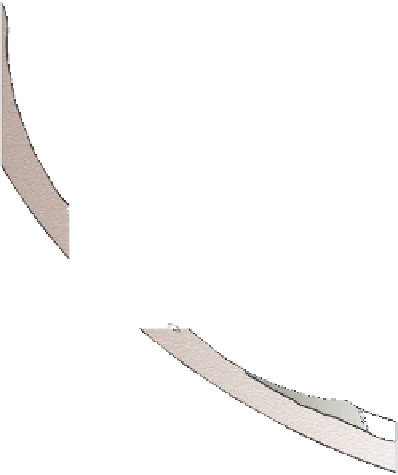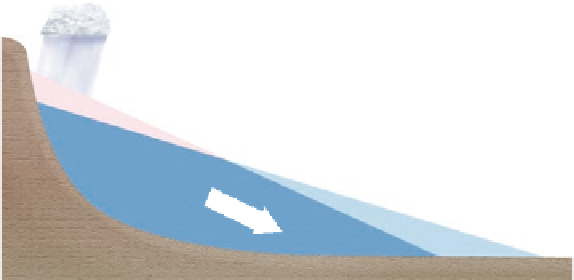Geoscience Reference
In-Depth Information
Figure 17.3 The transformation of snow to glacial
ice.
When snow first falls, it is 80% air. As snow
compacts, its density increases to the point that it
becomes granular. When these grains of snow be-
come more compact, they collectively form firn. With
additional compression, the firn becomes glacial ice.
In general, the most dense and compressed layers
of ice are at the bottom of a glacier, whereas the top
layers reflect relatively recent snowfalls.
Increased
compression
(1 month)
Snowflakes
Glacial ice
Granular
snow
Firn
(4-5 years)
Increased compression (1 year)
then refreezes at night. With additional compaction, pockets
of air in the firn further decrease in size or are squeezed out
entirely, and the ice crystals become aligned with one an-
other. At this time, the mass is 90% solid and begins to flow
slowly under its own weight, much like maple syrup across a
pancake. This point in the transformation of snow marks the
time when the ice mass is a glacier. In most mountain gla-
ciers, the full transformation to active glacier begins when
the snow and ice mass reach a depth of about 40 m (130 ft).
1
Accumulation of
ice from snowfall
2
Zone of
accumulation
3
Equilibrium line
5
Loss of ice by
evaporation
4
Zone of
ablation
The Glacial Mass Budget
Like streams, glaciers are natural systems that depend on
inputs and outputs to function. In the case of streams, the
input is liquid water in the form of precipitation, runoff, and
groundwater. The outputs are stream discharge and water va-
por (through evaporation). The input to the glacial system is
snow that accumulates at the upper end of the glacier (Figure
17.4). This area is fittingly called the
zone of accumulation
and is where the addition of annual snows exceeds what is
lost through melting, evaporation, and sublimation. Glacial
outputs occur primarily down the valley toward the front of
the glacier, where the temperatures are higher. This area is
called the
zone of ablation
(or
wastage
) and is the place
where more annual melting and evaporation of ice take place
6
Loss of ice
by meltwater
7
Crevasses
8
Direction of flow
(a)
+ Balance
(gain greater than loss)
Zone of accumulation
Equilibrium line
Zone of ablation
- Balance
(loss greater
than gain)
Figure 17.4 The glacial mass budget.
(a) The glacial mass
budget is the balance between snowfall in the zone of accumula-
tion and melting and evaporation at the zone of ablation. (b) Side
view of the glacial mass budget. Note the geographical relation-
ship of the zones of accumulation and ablation and the way in
which ice flows.
Direction
of flow
(b)
Zone of accumulation
The geographical area where snow
accumulates and feeds the growth of a glacier.
Zone of ablation
The part of a glacier where melting exceeds
snow accumulation.

